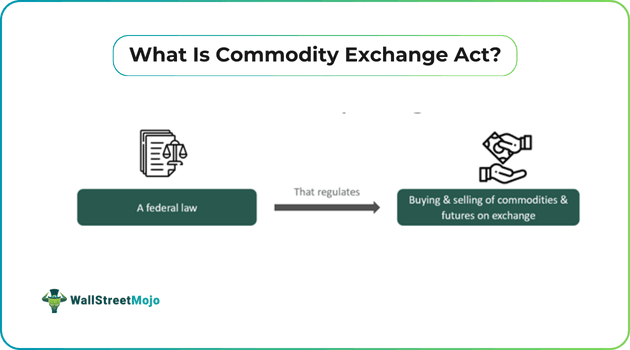Table of Contents
Commodity Exchange Act Definition
The Commodity Exchange Act (CEA) refers to the legislation passed for commodities and futures contracts traded in the market. This act is regulated by the Commodity Futures Trading Commission (CFTC). It aims to prevent any burden on commodities like grains traded and to limit short selling of the same on commodity exchanges.

In general, the Commodity Exchange Act of 1936 is a replacement for the "Grain Futures Act of 1922." It mainly worked on the trading of commodities in the financial markets. These include wheat, cotton, corn, rice, oats, barley, rye, flaxseed, and other grains.
Key Takeaways
- The Commodity Exchange Act (CEA) is a federal law announced by the Commodity Futures Trading Commission (CFTC) on June 15, 1936.
- This act was proposed as an amendment to the Grain Futures Act of 1922.
- It regulates and controls the activities and financial transactions involving commodities on the commodity exchange.
- The term commodities include "wheat, corn, cotton, barley, rye, flax seeds, rice, oats, and others." In 2022, a digital CEA was also proposed to cover assets traded via electronic means.
- Any violation of the act can result in a fine of up to $1,000,000 or 3x the amount of the gain achieved.
Commodity Exchange Act Explained
The Commodity Exchange Act of 1936 is a US law that establishes regulations for the commodities traded in exchanges. It creates legislation to prevent any fraudulent activities while dealing with such commodities. Also, this act oversees over-the-counter (OTC) swaps. Thus, it is easier to trade a futures contract if it is registered on the commodity exchange. However, there are specific inclusions in this act .
The CEA rules reside in Title 7 of the Federal Code. Under each, there are multiple chapters and subheadings. In total, 27 chapters detail the definition, requirements, prohibited transactions, reporting procedures, public disclosure, penalties for violations, and others. However, there are specific implications for failure or non-compliance. In short, if an investor or broker fails to follow the rules for conducting commodity or futures trading, they may face a penalty. For instance, Sections 6(c) and 9(a)(2) define a fine of up to $1,000,000, or triple the amount of the monetary gain accessed for CEA violations. This penalty also involves Section 753 of the Dodd-Frank Act since it tries to prevent a financial crisis due to it.
In addition to this act, the Digital Commodity Exchange Act was also passed in 2022. It focuses mainly on the digital version of commodities traded in the market. For instance, cryptocurrencies, digital tokens, electronic dealing in oil and gas, computing storage, and power. It also includes agricultural products traded as financial assets and livestock farming. Furthermore, the rules of the Digital Commodity Exchange Act also apply to futures or swaps, including such commodities.
Many traders use Saxo Bank International to research and invest in stocks across different markets. Its features like SAXO Stocks offer access to a wide range of global equities for investors.
History
The US Commodity Exchange Act of 1936 was an amendment released in response to the Grain Futures Act, which was proposed in 1922. However, the history of this act dates back to the early 19th century. At this time, the nation was blooming with the phenomena of nature. The boost in agricultural activities was visible in the production of wheat, rice, corn, rye, and oats. In the later stages, due to surplus production, a massive amount was also exported to other nations. As a result, the period between the 1840s and 1850s was termed an agricultural revolution. During this period, futures trading also became prevalent among the traders.
However, at this point, merchants tried to resell the forward contracts before delivery. In addition, many bucket shops created their presence. These shops acted as a marketplace where individuals tried to bet on commodity prices. However, these did not reflect on the futures contracts traded on the exchange. As a result, the prices of commodities were facing uneven volatility due to these shops. Therefore, in 1922, the Chicago Board of Trade (CBT) proposed the Grain Futures Act as an intervention tool to prevent such wagers. However, in the later stages, the urge to expand this act became aggressive in the legislature.
During this period, the United States was experiencing the ill effects of the Great Depression. As a response, Congress imposed various regulations on the NYSE (New York Stock Exchange). Moreover, the agricultural department also proposed some amendments to the Grain Futures Act. Thus, on June 15, 1936, the CEA came into existence.
Examples
Let us look at some examples to comprehend the concept in a better way:
Example #1
Suppose James is a businessman who loves to trade in the financial markets. For the past five years, he has owned a fast-food outlet that deals in burgers, subways, and fries. And as a significant ingredient, he requires wheat in the recipes. Therefore, James utilizes commodity futures to access wheat to make buns. At this point, he feels the price of the grain may shoot high. As a result, he decided to buy at an early rate.
After a few weeks, he entered into a future contract with Kevin and agreed to buy specific quantities at a decided price via the Chicago Board of Exchange. They submit their respective orders and deposit a margin as a requirement for the CEA. On the delivery date, Kevin fulfilled the obligation to sell, and James bought the required quantities from it.
Example #2
According to the recent news update, as of June 2023, the federal judiciary ordered Ooki DAO for illegal activities performed on commodity exchanges. The US District Judge William H. Orrick has alleged a civil penalty of $643,542 on futures commission merchants as per CEA. In addition, the judge also banned the Ooki DAO from any further trading and removed content from their website.
Importance
Following is the significance of the US CEA for investors as well as financial market players. Let us look at them:
- It helps regulate future contracts and obligations associated with the trading of these commodities.
- The CEA aims to prevent any fraud and prohibits such activities under the supervision of the CFTC (Commodity Futures Trading Commission).
- This act enhances the market integrity and maintains a steady balance in the exchange with the purpose of preventing any financial crisis.
- It also allows regulation on the swaps market to trade on regulated exchanges. Likewise, the CFTC has incorporated a general authority to combat irregularities in the cryptocurrency market.
- The CEA tends to promote the effectiveness of the federal markets by specific standards to protect the investor's interest vested in the financial instruments. Thus, it requires proper public disclosure of facts and registration on regulated exchanges.
Disclosure: This article contains affiliate links. If you sign up through these links, we may earn a small commission at no extra cost to you.

